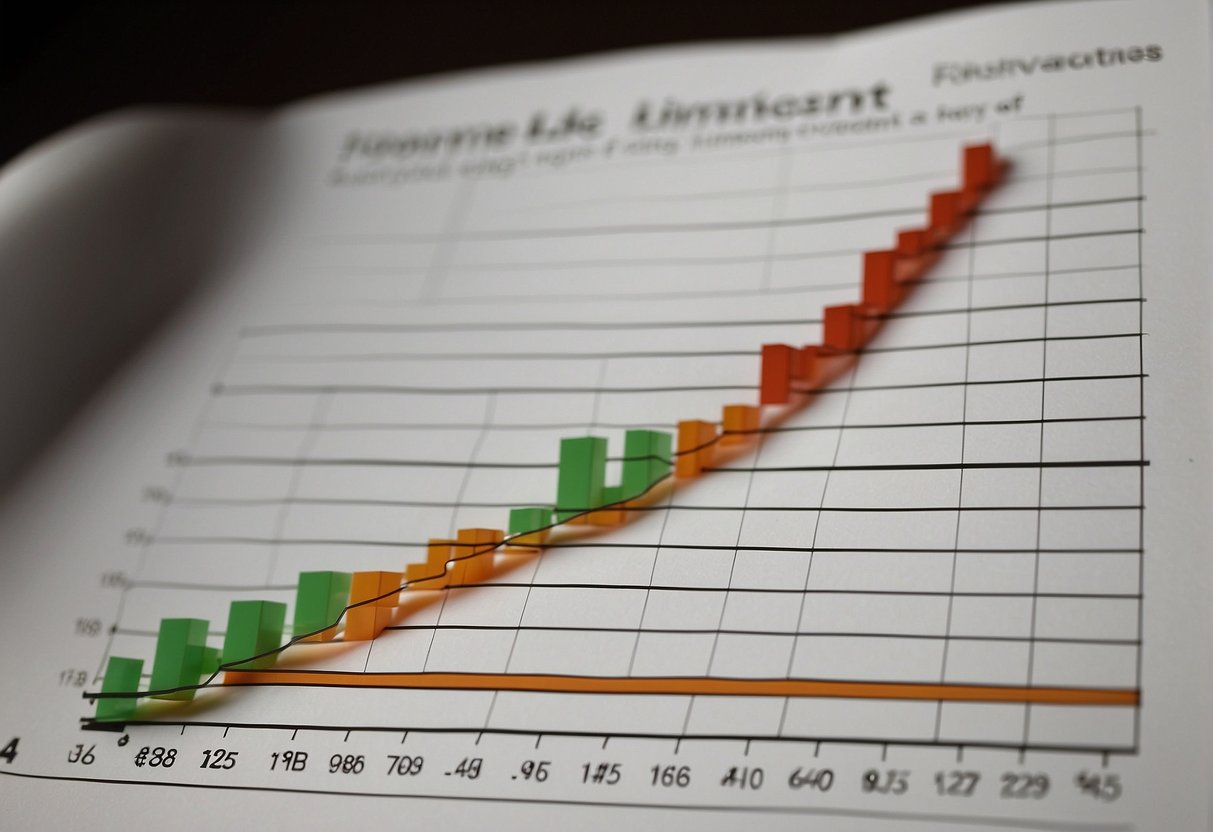Market timing is a widely debated investment strategy that involves buying and selling securities based on predictive methods, such as technical indicators or economic data. While the goal is to maximize returns, the tax implications of market timing must not be overlooked, as they can significantly impact an investor’s overall profitability.

Understanding the taxation of investment income is crucial when executing a market timing strategy. Different types of investments have varying tax consequences, such as short-term versus long-term capital gains taxes. Additionally, the impact of market timing on taxes can vary depending on profit and loss realization, deductions, and tax liability. Furthermore, regulatory compliance and the specific investment vehicles used also play a crucial role in determining the tax implications of market timing.
Key Takeaways
- Market timing strategies can impact tax consequences when realizing investment gains or losses.
- Tax implications vary based on the type of investment, such as short-term and long-term capital gains.
- Regulatory compliance and investment vehicles also play a vital role in the tax implications of market timing.
Understanding Market Timing
Financial Markets
Market timing is an investment strategy in which investors attempt to buy and sell assets, such as stocks and bonds, at the most reasonable times to capitalize on fluctuations in the financial markets. Success in market timing relies heavily on the investor’s ability to predict the direction of market movements and act accordingly and accurately.
Investment Strategies
Various strategies are associated with market timing, each with its own unique set of risks and potential rewards. Some investors rely on technical indicators, such as moving averages and trendlines, to identify potential market entry and exit points. Others may employ fundamental analysis, examining the underlying economic and financial conditions driving market trends. Knowing the different investment strategies can help investors choose the best approach for their risk tolerance and financial goals.
Predictive Methods
A key market timing component is using predictive methods to anticipate market trends and inform investment decisions. Some of these methods include technical indicators and economic data analysis. While these methods can provide valuable insights, it is essential to remember that market timing is not an exact science, and no predictive method is foolproof.
When engaging in market timing, investors must also be aware of the potential tax implications, mainly if they make frequent trades resulting in short-term capital gains. The tax implications can vary, so it’s essential to consult with a financial professional to understand the specific tax consequences associated with this strategy.
By understanding the critical aspects of market timing, such as financial markets, investment strategies, and predictive methods, investors can make more informed decisions about whether this approach aligns with their investment goals and risk appetite.
The Taxation of Investment Income

Capital Gains
Capital gains are profits made from the sale of an investment or asset, and they are subject to taxes. The tax rate applied to these gains depends on the asset’s holding period. Short-term capital gains arise from assets held for less than one year and are taxed at ordinary income tax rates. Long-term capital gains, however, are derived from assets held for more than one year and are taxed at 0%, 15%, or 20%, depending on the investor’s tax bracket.
Ordinary Income
Ordinary income is generated through employment, self-employment, rental, and interest earnings. The Internal Revenue Service (IRS) taxes ordinary income according to a taxpayer’s income bracket. Here is a summary of the tax rates for individual taxpayers:
- 10% for income up to $9,950
- 12% for income between $9,951 and $40,525
- 22% for income between $40,526 and $86,375
Note: These tax rates are for illustrative purposes only, and the actual rates may vary.
IRS Regulations
The IRS has specific regulations for reporting investment income on a taxpayer’s annual return. Investors must document their capital gains and losses, dividends, interest, and other investment income using Form 1040, the U.S. Individual Income Tax Return.
Taxpayers should use Form 8949 and Schedule D (Capital Gains and Losses) to report capital gains and losses accurately. Additionally, taxpayers should maintain proper records of investment transactions, including purchase and sale dates, the asset’s fair market value, and the holding period.
By understanding the tax implications of market timing and adhering to IRS regulations, investors can ensure they correctly report their investment income and avoid potential penalties.
Short-Term vs. Long-Term Capital Gains
Holding Period
The asset holding period is the primary difference between short-term and long-term capital gains. Short-term capital gains occur when an asset is sold after being held for one year or less, whereas long-term capital gains are derived from the sale of an asset held for more than a year. The holding period is crucial in determining the applicable capital gains tax rate.
Tax Rates Difference
Short-term and long-term capital gains are taxed at different rates. Short-term capital gains are generally taxed at the individual’s regular income tax rate. On the other hand, long-term capital gains enjoy more favorable tax rates, which can vary depending on the investor’s income level, and typically fall into three categories: 0%, 15%, or 20%.
To further illustrate the tax rate differences for short-term and long-term capital gains, consider the following table:
| Taxable Income (Single) | Taxable Income (Married Filing Jointly) | Short-Term Capital Gains Rate | Long-Term Capital Gains Rate (as of 2022) |
|---|---|---|---|
| $0 – $9,950 | $0 – $19,900 | 10% | 0% |
| $9,951 – $40,525 | $19,901 – $81,050 | 12% | 0% |
| $40,526 – $86,375 | $81,051 – $172,750 | 22% | 15% |
| $86,376 – $164,925 | $172,751 – $329,850 | 24% | 15% |
| $164,926 – $209,425 | $329,851 – $418,850 | 32% | 15% |
| $209,426 – $523,600 | $418,851 – $628,300 | 35% | 15% |
| Over $523,600 | Over $628,300 | 37% | 20% |
As seen in the table, long-term capital gains generally offer lower tax rates than those applied to short-term capital gains. These differences can significantly impact the taxes owed on investment earnings and incentivize investors to hold onto their assets for extended periods when planning their investment strategies.
The Impact of Market Timing on Taxes

Market timing refers to trading in and out of the stock market based on predictions of future price movements. This strategy targets buying low and selling high, which can significantly impact an investor’s tax situation. This section will discuss the tax implications of market timing, focusing on realizing capital gains and taxable events.
Capital Gains Realization
When an investor executes a market timing strategy, they are more likely to realize capital gains, which can increase their tax liability. Capital gains are classified as either short-term or long-term, depending on the holding period of the investment.
- Short-term capital gains are realized on investments held for less than 12 months and are taxed at the investor’s ordinary income tax rate.
- Long-term capital gains are realized on investments held for more than 12 months and are subject to a lower tax rate, ranging from 0% to 20%, depending on the investor’s taxable income.
A market timing strategy typically involves a higher frequency of trades, potentially resulting in a more significant proportion of short-term capital gains. This can lead to a higher tax liability, as short-term gains are taxed more than long-term gains.
Taxable Events
Market timing can result in numerous taxable events contributing to an investor’s overall tax liability. Some everyday taxable events associated with market timing include:
- Capital gains realization: As mentioned earlier, realized capital gains from selling investments are subject to taxation, with short-term gains being more heavily taxed.
- Dividend taxation: Market timing strategies may involve trading dividend-paying stocks, which can result in taxable dividend income. Dividends can be classified as qualified or nonqualified, affecting the applied tax rate.
- Interest income: Trading fixed-income securities, such as bonds, as part of a market timing strategy may lead to interest income, typically taxed as ordinary income.
Market timing can significantly influence an investor’s taxable income and overall tax consequences. It is essential for investors to understand the implications of market timing on their taxes and to consider their unique tax situation when implementing such a strategy.
Profits and Losses in Market Timing

Profits Realization
In market timing, profits are realized when an investor successfully sells a security at a higher price than purchased, resulting in a capital gain. Realizing profits through market timing requires a deep understanding and analysis of the various factors influencing the market and the specific security being traded.
Investors who engage in market timing strategies aim to capitalize on short-term fluctuations in the market to maximize their potential returns. While this can lead to lucrative gains for some, it is essential to consider the tax implications of realizing these profits.
Capital gains are subject to taxation, and the tax rates vary based on factors such as the investor’s income and the holding period of the investment. Short-term capital gains from securities held for less than a year are taxed at the investor’s ordinary income tax rate. In contrast, long-term capital gains from securities held for more than a year are subject to lower tax rates, depending on the investor’s income bracket1.
Reporting Losses
On the other hand, market timing strategies can also result in capital losses when an investor sells a security at a lower price than what it was purchased for. Reporting capital losses on your taxes can offset taxable capital gains. If taxpayers’ capital losses are more than their capital gains, they can use the difference to offset up to $3,000 of other taxable income (or $1,500 if married filing separately). Any remaining unused capital losses can be carried forward into future tax years.
To claim a capital loss on your taxes, you must follow the appropriate procedure for reporting the transactions on the required tax forms (such as the Federal Schedule D Form). It is essential for market timing investors to accurately track all their buying and selling transactions, along with the associated costs, to ensure they are paying the correct amount of taxes and claiming their eligible deductions.
In summary, market timing can have both profitable and adverse tax implications. Investors must be aware of these repercussions and ensure accurate reporting of their gains or losses from selling and buying securities.
Footnotes
- Tax Implications of Buying and Selling Stocks During the Market Downturn
- [IRS Publication 550 (2020), Investment Income and Expenses] (https://www.irs.gov/forms-pubs/about-publication-550)
Deductions and Tax Liability

Deducting Losses
In the context of market timing, investors may experience capital losses when selling securities at a lower price than they initially bought them. The good news is that capital losses can offset capital gains, thus reducing the overall taxable income. Investors can deduct up to $3,000 ($1,500 for married individuals filing separately) of their net capital losses against other income each year. Any remaining losses can be carried forward to future tax years.
To take advantage of these deductions, it is crucial to maintain accurate records of all transactions, such as buying and selling prices, dates, and fees. This information will help calculate the net capital gains or losses for tax purposes.
Calculating Liability
Investors must consider their overall capital gains and losses when calculating tax liability. Here’s a brief overview of how to calculate your tax liability from market timing activities:
- Classify gains/losses: Divide your transactions into short-term (held for one year or less) and long-term (held for more than one year) gains and losses.
- Net gains/losses: Calculate the short-term and long-term gains/losses by subtracting your losses from your gains in each category.
- Determine taxable income: Add your net short-term and long-term gains together. If you have a net loss, you can deduct up to the allowed amount against other income, as mentioned earlier.
- Apply tax rates: Your tax rates depend on your income level and filing status. Short-term gains are taxed at your ordinary income tax rate, whereas long-term gains are taxed at a lower rate.
Following these steps can help you calculate your tax liability from market timing activities. It is essential to comply with tax laws and report all relevant information accurately. Consult with a tax professional if you are unsure about the tax implications of your market timing strategies.
Footnotes
Trading Costs and Their Tax Implications

Commissions
Investors typically make numerous trades when engaging in market timing strategies, leading to increased trading costs. One of these costs includes the commissions investors must pay on each transaction. Previously, most brokerages charged a fee for each trade, which could significantly impact an investor’s overall returns. However, in recent years, many brokerage firms have started to offer commission-free trading, which may help reduce this burden for market timers.
It is important to note that while commissions used to be tax-deductible, recent changes to the tax code have eliminated this deduction. As of 2018, investors can no longer deduct commissions and other investment fees on their tax returns, making it essential to consider the impact of these expenses on their overall investment performance.
Other Transaction Costs
In addition to commissions, investors engaging in market timing must know other transaction costs, such as bid-ask spreads and slippage. Brokerages do not directly charge these costs but can still impact overall returns.
The bid-ask spread is the difference between the highest price a buyer is willing to pay for an asset (bid) and the lowest price a seller is willing to accept (ask). This spread represents a cost for investors when they buy and sell securities, affecting the price at which trades are executed. Wider spreads can lead to higher transaction costs, especially for frequent traders.
Slippage occurs when an investor’s order is executed at a worse price than expected due to market volatility or a lack of liquidity. This difference can result in a higher transaction cost as the investor may pay more to buy or receive less when selling than initially anticipated.
Regarding tax implications, out-of-pocket expenses like bid-ask spreads and slippage are generally not tax-deductible for individual investors. However, these transaction costs often affect the overall investment return, which can directly impact the amount of taxes an investor owes on their capital gains or losses from trading.
To better illustrate these concepts, let’s review an example:
- Investor A buys 100 shares of XYZ stock at $50 per share. The total cost, including a $5 commission, is $5,005.
- Investor A later sells 100 shares of XYZ stock at $55 per share. The total proceeds, minus a $5 commission, are $5,495.
- Based on these figures, the capital gain on this trade is calculated as follows:
Proceeds: $5,495 - Cost: $5,005 = Capital gain: $490
In this case, the investor needs to report the $490 capital gain on their tax return, and they will be taxed accordingly. The commissions paid on both transactions are included in calculating the capital gain but cannot be deducted separately as an itemized tax expense.
By understanding the impact of trading costs and their tax implications, investors can make more informed decisions regarding their market timing strategies and overall investment approach.
Market Timing for Professional Traders

Traders vs. Investors
Market timing is often practiced by professional traders, who attempt to predict short-term market fluctuations and capitalize on them to make profits. In contrast, full-time investors adopt a long-term approach, buying and holding assets with an expectation of appreciation over time. The tax implications for these two groups can be quite different. Professional traders’ profits generated from their short-term trading strategies are generally subject to higher tax rates than those applicable to long-term investors. As a result, professional traders must understand the tax consequences of their activities.
Professional Day Traders
Professional day traders often trade stocks, options, and other securities daily, looking for small price movements that can lead to profitable trades. These traders are typically classified as “traders” rather than “investors” for tax purposes. This distinction carries several tax implications:
- Ordinary income vs. capital gains: Profits earned by professional day traders are treated as ordinary income and are subject to higher tax rates than the long-term capital gains rates available to investors.
- Self-employment taxes: Professional traders may be subject to self-employment taxes and income taxes because they are considered self-employed.
- Mark-to-market accounting: Professional traders can use mark-to-market accounting, which allows them to report unrealized gains and losses at the end of the year and potentially offset them against other income.
In conclusion, professional traders who practice market timing are subject to different tax implications compared to long-term investors. Understanding these differences and considering them in their trading strategies can help minimize their tax liabilities and maximize their overall profits.
Footnotes
Investment Vehicles and Tax Implications

Actively Managed Funds
Actively managed funds are investment portfolios where the fund manager decides to buy, sell, or hold securities to outperform a specific market benchmark. These funds often have higher turnover rates, which could result in higher capital gains taxes for investors. Additionally, fund managers may conduct frequent market timing trades, which can generate short-term capital gains taxed at a higher rate than long-term capital gains. To counterbalance these tax implications, some investors opt for tax-efficient, actively managed funds focusing on minimizing the tax burden. For instance, these funds may employ strategies like tax-loss harvesting or holding securities for extended periods to qualify for lower long-term capital gains tax source.
Passive Investment Strategies
Passive investment strategies, like index funds or exchange-traded funds (ETFs), aim to replicate the performance of a particular market index by holding all the securities within that index. Passive funds typically have lower turnover rates than actively managed funds, resulting in fewer taxable events from selling securities.
Investors following a buy-and-hold strategy can benefit from the long-term tax advantages of passively managed funds. Holding investments for more than one year qualifies them for favorable long-term capital gains treatment, typically at a lower tax rate than short-term capital gains source.
Diversification is another benefit of passive investment strategies, as it reduces the portfolio’s exposure to volatile market movements. This helps to minimize the chances of an investor needing to sell a security at an unfavorable time and realize capital gains taxes.
In conclusion, understanding the tax implications of different investment vehicles and strategies helps investors make informed decisions about their portfolios. Actively managed funds and passive investment strategies have different tax consequences, and savvy investors can use this knowledge to optimize their investment portfolios tax-efficiently.
Sector-Specific Tax Considerations
In addition to the general tax implications of market timing, investors need to be aware of some sector-specific tax considerations. These include aspects like sector volatility and the role of target-date funds.
Sector Volatility
Some sectors are more volatile than others, which may impact the tax implications of market timing. For instance, technology and biotechnology industries tend to experience higher levels of market volatility compared to more stable sectors such as utilities. This higher volatility can lead to more frequent realization of capital gains and losses, potentially affecting the investor’s tax bill.
Investors must consider the tax implications of the specific sector they are investing in, especially when employing a market timing strategy. Focusing on U.S. large-cap funds, for example, may lead to different tax consequences than investing in more volatile, higher-growth sectors.
Target-Date Funds
Target-date funds (TDFs) are a popular investment option for retirement savings. They generally involve a mix of stocks, bonds, and cash equivalents, with the asset allocation becoming more conservative as the target retirement date approaches. When employing market timing strategies within TDFs, investors must be mindful of the tax consequences.
The management of TDFs usually requires more frequent rebalancing, which can lead to taxable events. For example, if an investor sells stocks to rebalance their portfolio, they may trigger capital gains taxes. Additionally, target-date funds typically include investments in multiple sectors, and investors need to consider the varying tax implications of each industry.
In conclusion, investors must understand the sector-specific tax implications of market timing to make informed investment decisions. Attention to details like sector volatility and target-date funds can help minimize unexpected tax consequences and optimize investment returns.
The Role of Diversification in Market Timing
Portfolio Management
In investment management, portfolio diversification is a critical strategy that aims to mitigate potential risks by spreading investments across various asset classes. Portfolio Managers often emphasize the importance of diversification to minimize the impact of market fluctuations and enhance long-term returns. A well-diversified portfolio is designed to weather market volatility, while market timing relies on making tactical decisions based on predictions of short-term market movements.
In comparison, market timing is riskier and can lead to significant tax implications if not executed correctly. By opting for a diversified investment strategy, investors and portfolio managers can focus on long-term growth and minimize the need for market timing.
Diversified Investments
A diversified portfolio typically contains a mix of asset classes, such as stocks, bonds, real estate, and cash, each with varying levels of risk and return. A diverse investment mix can help reduce overall portfolio risk and enhance returns over time, as it can lower the impact of underperforming assets on the entire portfolio.
- Stocks: Equities can help provide a steady stream of returns in the long run and potentially deliver higher gains when compared to other asset classes. However, stock investments come with inherent risks tied to market fluctuations.
- Bonds: Fixed-income investments, like bonds, provide regular income through periodic interest payments. They typically carry lower risk than stocks, and bonds can also act as a buffer during periods of market downturns.
- Real Estate: Known for delivering a steady income through rent or capital appreciation, real estate investments can diversify an investor’s portfolio and provide long-term growth opportunities.
- Cash: Keeping a portion of the portfolio in cash and cash equivalents (e.g., money market funds) can help cushion against market volatility and offer a safety net during periods of uncertainty.
In summary, embracing diversification in portfolio management can serve as a solid alternative to market timing. By embracing diversified investments, investors are better prepared to handle market fluctuations while minimizing potential tax implications that come with frequent asset buying and selling. Investors can sustain their financial growth with a reduced risk profile by focusing on a long-term strategy built on the foundation of diversification.
Regulatory Compliance and Market Timing
IRS Regulations
The Internal Revenue Service (IRS) plays a crucial role in overseeing tax implications related to market timing. While market timing is not illegal, it may result in short-term capital gains that are taxed at a higher rate than long-term gains. According to the IRS, short-term capital gains are subject to standard income tax rates, whereas long-term capital gains are subjected to a more favorable tax rate.
Investors engaging in market timing should know the holding period requirements for assets to qualify for long-term capital gains treatment. To be considered long-term, assets must be held for more than one year. Short-term investments are those held for one year or less and are subject to a higher tax rate. Additionally, investors should take note of the wash-sale rule, which prohibits the claim of a tax loss on a sale of securities if a substantially identical security is purchased within 30 days before or after the sale.
Compliance Measures
Market participants may need to adopt specific strategies and measures to minimize tax implications and maintain regulatory compliance. Some examples include:
- Tax-loss harvesting involves selling an underperforming asset to offset capital gains on another asset. This strategy reduces taxable income and gives the investor the opportunity to reinvest the proceeds in a similar security with better prospects.
- Portfolio diversification: Spreading investments across various asset classes to help lower risks and minimize potential tax liabilities.
- Tax-efficient investments: Investing in tax-advantaged accounts, such as Individual Retirement Accounts (IRAs) or 401(k)s, to reduce or defer tax liabilities.
- Tax-aware asset allocation: Placing investments in appropriate accounts (e.g., high-growth assets with significant short-term gains in tax-advantaged accounts, while long-term stable assets are placed in taxable accounts).
Market participants must fully know IRS regulations and integrate appropriate compliance measures into their investment strategies to mitigate tax implications. By staying informed on current tax laws, investors can be more confident and knowledgeable in their market timing decisions while maintaining a neutral stance on potential risks.
Advanced Market Timing Techniques
Chart Analysis
Chart analysis, or technical analysis, is a widely used technique for market timing. It involves studying past price movements and trends to predict future market behavior. Technical analysts use tools such as moving averages, trendlines, and support and resistance levels. For example, a standard chart pattern called the head and shoulders pattern is considered a bearish reversal signal, often indicating a change in a trend.
Essential Tools in Chart Analysis:
- Moving Averages: The moving average helps smoothen price data by creating a constantly updated average price. It can be classified as simple, exponential, or weighted based on how it is calculated. A common strategy is looking at two moving averages with different time frames, like the 50-day and the 200-day moving averages. A crossover between these lines can be seen as a buy or sell signal.
- Trendlines and Channels: Trendlines are lines drawn on a price chart, connecting at least two price points to show a trend’s direction and strength. An upward-sloping trendline indicates bullish momentum, while a downward-sloping trendline signifies bearish momentum. Channels are formed by two parallel trendlines acting as the support and resistance levels for an asset’s price movement.
Economic Forecasts
Economic forecasts play a significant role in market timing strategies. It involves analyzing various economic indicators to predict the market’s future direction. Economic indicators include GDP growth, employment data, inflation rates, and consumer sentiment. For example, high GDP growth may reflect a bullish market, while high unemployment rates may forecast a bearish market.
Combining chart analysis and economic forecasts could help market timers make more informed decisions. While chart analysis focuses on historical price patterns, economic forecasts offer insights into the economy’s health. However, it’s crucial to note that no market timing strategy is foolproof, and investors should remain cautious of the potential tax implications and additional risks tied to frequent trading.
In summary, advanced market timing techniques involve chart analysis and economic forecasts to make informed buy and sell decisions. By understanding these techniques deeply, investors may better position themselves to capitalize on market trends and navigate potential pitfalls. However, it is not without risks and should be approached carefully.
Challenges and Criticism of Market Timing
Criticism
Market timing, a strategy in which investors attempt to predict market movements and capitalize on them, has faced significant criticism from financial experts and researchers. A notable example is Nobel Laureate William Sharpe’s 1975 study, “Likely Gains From Market Timing,” which highlighted the challenge of consistently outperforming passive index funds through market timing strategies. Critics argue that this method is risky and can lead to suboptimal results for the average investor.
Drawbacks
There are several drawbacks associated with market timing that investors should consider before embracing this approach:
- Difficulty in predicting market movements: Market timing relies on the ability to accurately predict market trends, which is challenging even for experienced professionals. According to a Forbes article, investors in equity funds have lagged the S&P 500 benchmark by an average of 4.66% per year, partly due to poor timing decisions.
- High trading costs and taxes: Market timing often involves frequent trading, increasing transaction costs. Additionally, this strategy can result in higher taxes, as gains are realized more frequently than a buy-and-hold strategy, which tends to have lower taxes.
- Short-term focus: Market timing emphasizes short-term predictions, potentially causing investors to overlook long-term trends and miss out on stable, long-term growth opportunities. A longer-term focus, like the one found in time spent in the market, can provide better results for many investors.
While some proponents of market timing argue that it can lead to higher returns in specific scenarios, its drawbacks and risks often outweigh the potential benefits for the average investor.
Frequently Asked Questions
How does frequent buying and selling impact capital gains tax?
Frequent buying and selling can significantly impact an investor’s capital gains tax. Generally, profits from selling assets are subject to capital gains tax, categorized into short-term and long-term gains. When investors actively trade and hold assets for less than a year, they must pay short-term capital gains tax, which is generally higher than the rate for long-term capital gains.
What are the implications of short-term vs. long-term capital gains for active traders?
Short-term capital gains, resulting from assets held for less than one year, are taxed at the investor’s ordinary income tax rate. These rates are typically higher than long-term capital gains rates, which apply to assets held for over a year. Long-term capital gains tax rates are lower, ranging from 0% to 20%, depending on the investor’s income level. Active traders who frequently buy and sell assets within short periods may face higher tax implications due to the increased rates applied to short-term gains.
Are there any specific tax penalties for engaging in market timing within a 401(k) or IRA?
Market timing within tax-deferred accounts like a 401(k) or IRA does not generally result in immediate tax penalties. However, these retirement accounts have annual contribution limits, and engaging in frequent trading within such accounts can affect the overall growth potential. Additionally, any withdrawals made before age 59 and a half may be subject to a 10% early withdrawal penalty and income taxes.
How does the wash-sale rule affect market timing strategies and their tax consequences?
The wash-sale rule is a tax regulation that prevents investors from claiming a loss if they buy a “substantially identical” security within 30 days before or after selling it at a loss. This rule can affect market timing strategies by disallowing the recognition of losses for tax purposes, thus increasing the investor’s taxable income.
In what ways do taxes reduce the benefits of successful market timing?
Taxes can reduce the benefits of successful market timing through the potential for higher short-term capital gains rates, disallowing the recognition of losses due to the wash-sale rule, and limiting the overall growth potential of tax-deferred accounts like 401(k)s and IRAs. Successful market timing strategies may result in increased taxable income, potentially offsetting gains and reducing the overall effectiveness of the approach.
Can market timing in investment strategies lead to higher tax brackets?
Using market timing in investment strategies can potentially lead to higher tax brackets. If an investor’s constant buying and selling results in substantial short-term capital gains, their taxable income may increase, pushing them into a higher income tax bracket. Additionally, higher taxable income can result in higher taxes on long-term capital gains and limit the benefits of lower long-term rates.
Conclusion
In summary, the tax implications of market timing can vary depending on the individual’s trading frequency and the nature of their gains. Frequent trading, as often seen in market timing, can result in higher transaction costs and increased taxes due to the more frequent realization of gains.
One of the leading tax implications of market timing is the short-term capital gains tax. If an investor buys and sells a security within a year, the gains are considered short-term and taxed higher than long-term capital gains. This could lead to a significant tax burden, especially for high-income earners.
Another tax aspect to consider is the recaptured depreciation. This occurs when an asset’s value is depreciated for tax purposes over time, and the investor sells the asset at a profit. The difference between the sale price and the depreciated cost could be subject to a recaptured depreciation tax.
Investors should be cautious of these tax implications while using market timing strategies, as they can quickly erode profits. In contrast, a buy-and-hold strategy typically involves fewer trades, potentially resulting in lower taxes and transaction costs.
Lastly, investors must consult with their tax advisors or financial professionals to understand the tax implications of market timing and make informed decisions that align with their financial goals.




